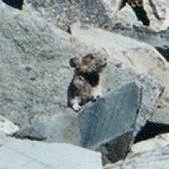Rocky
HUNTING THE PASAYTEN FOR DEER AND BEAR
By Rocky Ross
Preface
I've never felt the need to begin a hunting journal entry with a preface but this hunt was different from any I had ever been on, for several reasons. First, it was an early season buck hunt in an area I had never hunted before. Second, I would be hunting with 2 partners 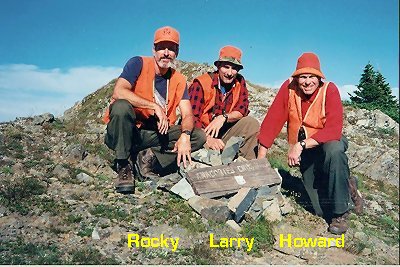 who I had never hunted with, and third, the hunt took place in two distinct parts.
who I had never hunted with, and third, the hunt took place in two distinct parts.
 who I had never hunted with, and third, the hunt took place in two distinct parts.
who I had never hunted with, and third, the hunt took place in two distinct parts.Howard Gardner, 70 is a retired metallurgical engineer, avid sportsman and in more recent years, a bicyclist. He is a longstanding member of the Richland Rod & Gun Club and has hunted almost everything, everywhere. To celebrate his 70th birthday this year, he rode in the STP, a bike run from Seattle to Portland. He made the 200-mile ride in one day.
Larry Martin, 50, works for Battelle Northwest as an air quality technician, assuring work zones are free from contaminants. Larry is also an avid sportsman and Rod & Gun Club member. Larry, like me, has not experienced the diversity of outdoor experiences that Howard has enjoyed, but he's a long-time, all around sportsman.
Larry and Howard began hiking and hunting together about 10 years ago. They asked me to go on an early buck hunt last year but I turned them down because I was too busy. When they asked again this year, I figured I better take them up on it or they might never ask again….a good decision on my part. I knew the hunting protocol would be different from my hunts with partners John and Ward Andrews so I made up a list and started asking questions. Eventually, a picture started forming in my mind what this hunt would be like and I started planning accordingly.
The first thing we would do is make a weekend trip into the Pasayten Wilderness to clear the trail so our packs wouldn't hang up on the trailside brush. We hiked all the way into camp, cutting limbs and brush as we went with loppers and bow saws. It took us 10 hours and I, for one, was pretty worn out when we reached camp. Howard was just coming off a bout of pneumonia so he was feeling particularly low on energy. I tried to keep in perspective that he was 70, just got over pneumonia, and hiked and cleared brush for 10 hours. I tried to keep my whining to myself.
The next day we slept in a bit before they showed me a brief preview of the areas we would be hunting. We then did a bit more trail maintenance before hiking out in a pouring rainstorm. The trip out took 6 hours and this experience was a good little tune up for the trip that lay ahead.
The Trip In
Anyone who knows Howard, knows he's a detail guy. Someone in any group needs to take the lead on details and Howard was a natural. He figures that a pack should weigh between 55 and 60 pounds for a 5-day hunt. I missed that target by 10 pounds but still had the lightest pack of any other backpack hunting trip I'd ever been on. We would only be carrying our packs part way to the camp because Larry's one-wheeled cart was used to haul everything down a closed road to the actual trailhead. 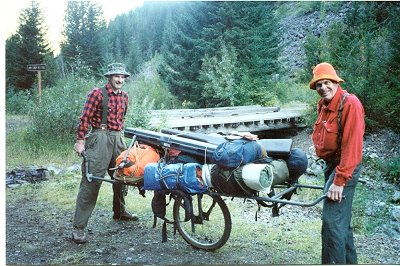 A bridge across Slate Creek is too rotten to support vehicles so the US Forest Service closed it. All-terrain vehicle traffic kept most of the road beyond the bridge passable, but some sections were challenging due to slides.
A bridge across Slate Creek is too rotten to support vehicles so the US Forest Service closed it. All-terrain vehicle traffic kept most of the road beyond the bridge passable, but some sections were challenging due to slides.
 A bridge across Slate Creek is too rotten to support vehicles so the US Forest Service closed it. All-terrain vehicle traffic kept most of the road beyond the bridge passable, but some sections were challenging due to slides.
A bridge across Slate Creek is too rotten to support vehicles so the US Forest Service closed it. All-terrain vehicle traffic kept most of the road beyond the bridge passable, but some sections were challenging due to slides.Managing the cart took some getting used to because it was a pretty big load with just a single wheel under it and it became a real balancing act. We would rotate through cart detail, with one of us on each end and the third guy just walking alongside. Every 15 minutes we'd make a rotation so each person got a rest every 30 minutes. The road was generally flat to slightly downhill so this part of the trip was relatively easy. The road ended at the Chancellor Campground and that's where we stashed the cart, gun cases and shouldered the packs.
We crossed a foot bridge on Canyon Creek and began our trek. We immediately had to cross a very large rockslide but the trail was in pretty good shape except for a recent slide. 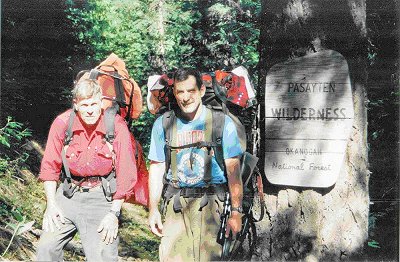 We carefully picked our way across it, then continued following the creek for about ½ mile before starting the long, uphill climb. We began working up a series of short, steep switchbacks. Each one had a progressively larger slide cutting across the trail. At the top, the slide was so big, we used a climbing rope to belay each other across it. I remember thinking that the extra precaution was probably unnecessary but it was a long way down if someone lost their footing and with a heavy pack, serious injury was very likely. Looking back on it, I now know it was the right choice. We used a pick to rebuild the trail a bit and then stashed the pick and continued up the trail.
We carefully picked our way across it, then continued following the creek for about ½ mile before starting the long, uphill climb. We began working up a series of short, steep switchbacks. Each one had a progressively larger slide cutting across the trail. At the top, the slide was so big, we used a climbing rope to belay each other across it. I remember thinking that the extra precaution was probably unnecessary but it was a long way down if someone lost their footing and with a heavy pack, serious injury was very likely. Looking back on it, I now know it was the right choice. We used a pick to rebuild the trail a bit and then stashed the pick and continued up the trail.
 We carefully picked our way across it, then continued following the creek for about ½ mile before starting the long, uphill climb. We began working up a series of short, steep switchbacks. Each one had a progressively larger slide cutting across the trail. At the top, the slide was so big, we used a climbing rope to belay each other across it. I remember thinking that the extra precaution was probably unnecessary but it was a long way down if someone lost their footing and with a heavy pack, serious injury was very likely. Looking back on it, I now know it was the right choice. We used a pick to rebuild the trail a bit and then stashed the pick and continued up the trail.
We carefully picked our way across it, then continued following the creek for about ½ mile before starting the long, uphill climb. We began working up a series of short, steep switchbacks. Each one had a progressively larger slide cutting across the trail. At the top, the slide was so big, we used a climbing rope to belay each other across it. I remember thinking that the extra precaution was probably unnecessary but it was a long way down if someone lost their footing and with a heavy pack, serious injury was very likely. Looking back on it, I now know it was the right choice. We used a pick to rebuild the trail a bit and then stashed the pick and continued up the trail.When we reached the "alder patch", it was very clear how valuable our time investment was to clear the trail on our earlier hike. It would have been miserable struggling through all the limbs that crisscrossed the trail, with our packs hanging up every few feet. Howard and Larry learned the hard way on their first trip into this area. Had I been on that trip, I probably would have suggested that we hunt elsewhere. 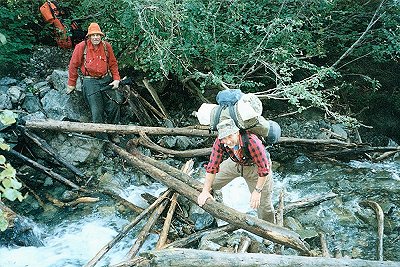 Beyond the "alder patch" was another challenge….a creek crossing. It wasn't a particularly large creek but the footing across moss-covered rocks and logs was a bit dicey. We picked our route and took our time. From there, it was another series of long switchbacks until we made camp. It seemed like the next 4 days were nothing but uphill.
Beyond the "alder patch" was another challenge….a creek crossing. It wasn't a particularly large creek but the footing across moss-covered rocks and logs was a bit dicey. We picked our route and took our time. From there, it was another series of long switchbacks until we made camp. It seemed like the next 4 days were nothing but uphill.
 Beyond the "alder patch" was another challenge….a creek crossing. It wasn't a particularly large creek but the footing across moss-covered rocks and logs was a bit dicey. We picked our route and took our time. From there, it was another series of long switchbacks until we made camp. It seemed like the next 4 days were nothing but uphill.
Beyond the "alder patch" was another challenge….a creek crossing. It wasn't a particularly large creek but the footing across moss-covered rocks and logs was a bit dicey. We picked our route and took our time. From there, it was another series of long switchbacks until we made camp. It seemed like the next 4 days were nothing but uphill.The best thing about hiking with Howard and Larry is that they actually stop to rest occasionally. And, they stop to eat. When I hike with John and Ward, we usually don't take the packs off until we reach camp. John has about a 38-inch inseam and used to run marathons. Ward is built like a fire plug, with thighs like nail kegs. After hiking with them I generally suffer for the next 3 days. On this trip, I wasn't sore at all, in spite of the heavy pack and gain in altitude.
The Camp
Interesting place.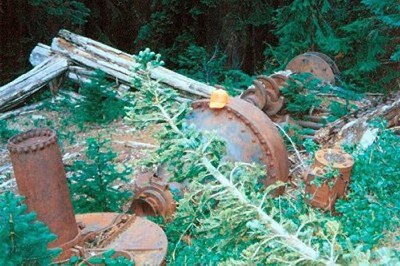 I truly believe that Howard and Larry found the only flat spot in the entire wilderness area to camp. The site was part of an old mining operation, with tangible remnants of old log cabins and ore crushing equipment. We're talking substantial equipment; stuff that weighs tons, and I just marveled at how someone could get that kind of stuff into this area. Our flat campsite was just large enough for our two small tents and an overhead tarp where we could cook and eat. The tarp was large enough that we could sit under one side of it, right next to the fire, and still have room for packs, guns, dry firewood, etc. right behind us.
I truly believe that Howard and Larry found the only flat spot in the entire wilderness area to camp. The site was part of an old mining operation, with tangible remnants of old log cabins and ore crushing equipment. We're talking substantial equipment; stuff that weighs tons, and I just marveled at how someone could get that kind of stuff into this area. Our flat campsite was just large enough for our two small tents and an overhead tarp where we could cook and eat. The tarp was large enough that we could sit under one side of it, right next to the fire, and still have room for packs, guns, dry firewood, etc. right behind us.
 I truly believe that Howard and Larry found the only flat spot in the entire wilderness area to camp. The site was part of an old mining operation, with tangible remnants of old log cabins and ore crushing equipment. We're talking substantial equipment; stuff that weighs tons, and I just marveled at how someone could get that kind of stuff into this area. Our flat campsite was just large enough for our two small tents and an overhead tarp where we could cook and eat. The tarp was large enough that we could sit under one side of it, right next to the fire, and still have room for packs, guns, dry firewood, etc. right behind us.
I truly believe that Howard and Larry found the only flat spot in the entire wilderness area to camp. The site was part of an old mining operation, with tangible remnants of old log cabins and ore crushing equipment. We're talking substantial equipment; stuff that weighs tons, and I just marveled at how someone could get that kind of stuff into this area. Our flat campsite was just large enough for our two small tents and an overhead tarp where we could cook and eat. The tarp was large enough that we could sit under one side of it, right next to the fire, and still have room for packs, guns, dry firewood, etc. right behind us.Larry and Howard slept in their tent and I slept in my little 1-1/2 man tent that is just large enough for me and my gear. A small spring seeped from the hillside about 30 yards from the camp. Every day we would take turns filling a collapsible water jug for camp water. We didn't filter it or boil it (except for soup and coffee). We just drank it straight out of the ground. Last year, this spring dried up for the first time since the guys started hunting here. This year there was just a trickle. I scooped out the collection basin so more water would pool up. We dipped it out with a small tin cup. It took about 35 dips to fill the water jug, which drew the small pool down about one inch. Pretty meager water supply but it worked just fine. The alternative was to hike uphill into the first basin, which would have been pretty inconvenient.
A small spring seeped from the hillside about 30 yards from the camp. Every day we would take turns filling a collapsible water jug for camp water. We didn't filter it or boil it (except for soup and coffee). We just drank it straight out of the ground. Last year, this spring dried up for the first time since the guys started hunting here. This year there was just a trickle. I scooped out the collection basin so more water would pool up. We dipped it out with a small tin cup. It took about 35 dips to fill the water jug, which drew the small pool down about one inch. Pretty meager water supply but it worked just fine. The alternative was to hike uphill into the first basin, which would have been pretty inconvenient.
 A small spring seeped from the hillside about 30 yards from the camp. Every day we would take turns filling a collapsible water jug for camp water. We didn't filter it or boil it (except for soup and coffee). We just drank it straight out of the ground. Last year, this spring dried up for the first time since the guys started hunting here. This year there was just a trickle. I scooped out the collection basin so more water would pool up. We dipped it out with a small tin cup. It took about 35 dips to fill the water jug, which drew the small pool down about one inch. Pretty meager water supply but it worked just fine. The alternative was to hike uphill into the first basin, which would have been pretty inconvenient.
A small spring seeped from the hillside about 30 yards from the camp. Every day we would take turns filling a collapsible water jug for camp water. We didn't filter it or boil it (except for soup and coffee). We just drank it straight out of the ground. Last year, this spring dried up for the first time since the guys started hunting here. This year there was just a trickle. I scooped out the collection basin so more water would pool up. We dipped it out with a small tin cup. It took about 35 dips to fill the water jug, which drew the small pool down about one inch. Pretty meager water supply but it worked just fine. The alternative was to hike uphill into the first basin, which would have been pretty inconvenient.We had cut some small limbs up for firewood on our first trip and we left a small blue tarp to cover the pile so we would have dry wood when we arrived for the hunt. Our fire was always pretty small so we just gathered small limbs (about 1 inch diameter) for fuel. The tiny twigs still attached to the base limbs on fir trees was our kindling. The weather was dry so fire starting was never a problem. Even a little rain probably wouldn't have been an issue. Two rocks supported a small section of grill and we mostly used the fire to cook. Howard would start up his stove in the morning to quickly heat water for breakfast but I think the fire would have actually heated it as fast. The camp was Spartan, and close-quartered, but perfectly adequate.
An interesting side note about how we all evolved as fire managers. I've always tended to get my face down low to the base of the fire and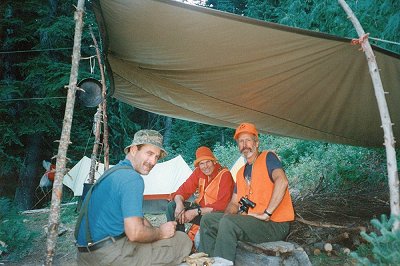 blow long, steady breaths, to imitate the bellows in a forge. That's the way my Dad taught me. He also taught me the alternative method of using a paper plate to fan the base of the fire with short, rapid strokes. This technique, practiced by Larry, was also patterned after the bellows/forge scenario. Since my Dad was a blacksmith of sorts, that all made sense. Howard had an altogether different technique. He would straddle the fire and use the same scrap piece of tin that Larry used, only he would swing his arm like a pendulum, in big wide arcs. Ashes would billow out in all directions and fill the camp, leaving us gasping for clean air. Needless to say, I tried to keep the fire going so we wouldn't end up like those poor saps who got covered with ash when Mt. Vesuvius blew its top. It's a struggle being the new guy in hunting camp.
blow long, steady breaths, to imitate the bellows in a forge. That's the way my Dad taught me. He also taught me the alternative method of using a paper plate to fan the base of the fire with short, rapid strokes. This technique, practiced by Larry, was also patterned after the bellows/forge scenario. Since my Dad was a blacksmith of sorts, that all made sense. Howard had an altogether different technique. He would straddle the fire and use the same scrap piece of tin that Larry used, only he would swing his arm like a pendulum, in big wide arcs. Ashes would billow out in all directions and fill the camp, leaving us gasping for clean air. Needless to say, I tried to keep the fire going so we wouldn't end up like those poor saps who got covered with ash when Mt. Vesuvius blew its top. It's a struggle being the new guy in hunting camp.
 blow long, steady breaths, to imitate the bellows in a forge. That's the way my Dad taught me. He also taught me the alternative method of using a paper plate to fan the base of the fire with short, rapid strokes. This technique, practiced by Larry, was also patterned after the bellows/forge scenario. Since my Dad was a blacksmith of sorts, that all made sense. Howard had an altogether different technique. He would straddle the fire and use the same scrap piece of tin that Larry used, only he would swing his arm like a pendulum, in big wide arcs. Ashes would billow out in all directions and fill the camp, leaving us gasping for clean air. Needless to say, I tried to keep the fire going so we wouldn't end up like those poor saps who got covered with ash when Mt. Vesuvius blew its top. It's a struggle being the new guy in hunting camp.
blow long, steady breaths, to imitate the bellows in a forge. That's the way my Dad taught me. He also taught me the alternative method of using a paper plate to fan the base of the fire with short, rapid strokes. This technique, practiced by Larry, was also patterned after the bellows/forge scenario. Since my Dad was a blacksmith of sorts, that all made sense. Howard had an altogether different technique. He would straddle the fire and use the same scrap piece of tin that Larry used, only he would swing his arm like a pendulum, in big wide arcs. Ashes would billow out in all directions and fill the camp, leaving us gasping for clean air. Needless to say, I tried to keep the fire going so we wouldn't end up like those poor saps who got covered with ash when Mt. Vesuvius blew its top. It's a struggle being the new guy in hunting camp.The Food
The food arrangement was definitely more coordinated than on any other trip I'd been on. John and Ward and I always do our own thing on these backpack hunts. We each take a stove and all our own food and we cook separately. I never considered doing it any other way. I'm the stickler for details in our group. John is much less so than me and Ward doesn't know the meaning of details. He just goes for the gusto! Coordinating group meals just never even crossed my mind.
Howard is the guru of planning. He keeps track of every detail of every trip and probably has done so since he started hunting. He had everything planned out and I just followed along. For breakfast and lunch we were on our own. 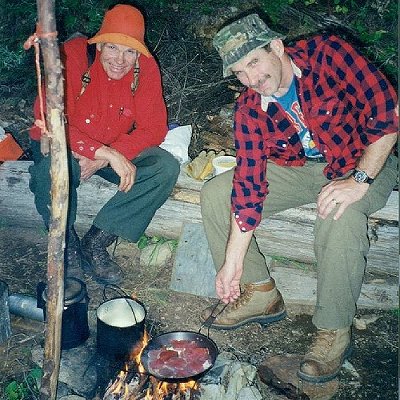 The main dinner course was a community effort but if you wanted other items, like a roll, vegetable, cup of soup, etc., that was up to the individual. Our first dinner was 2 large chunks of venison loin, carved up into steaks. Larry cut them up and I casually mentioned that the pile seemed pretty big for 3 guys. We took turns frying pans full and scarfed all of it up, looking for more. The other community dish was a couple servings of Lipton's instant dinners. These are really cheap and taste a whole lot better than standard dehydrated food. Each night these Lipton's dinners were the basis of our community meal, usually with some type of meat added (hot dogs, Polish sausage, canned chicken or ham, etc.) We'd start off with a cup of soup and work into the rest. There was always more food than we could eat so the camp robbers got a treat the next day. Hot water was kept hot at the edge of the fire in a large aluminum coffee pot and the community meal was cooked in an open aluminum pot. An SOS pad was a must to clean the residue from the pot, as sandblasters are hard to fit in a pack.
The main dinner course was a community effort but if you wanted other items, like a roll, vegetable, cup of soup, etc., that was up to the individual. Our first dinner was 2 large chunks of venison loin, carved up into steaks. Larry cut them up and I casually mentioned that the pile seemed pretty big for 3 guys. We took turns frying pans full and scarfed all of it up, looking for more. The other community dish was a couple servings of Lipton's instant dinners. These are really cheap and taste a whole lot better than standard dehydrated food. Each night these Lipton's dinners were the basis of our community meal, usually with some type of meat added (hot dogs, Polish sausage, canned chicken or ham, etc.) We'd start off with a cup of soup and work into the rest. There was always more food than we could eat so the camp robbers got a treat the next day. Hot water was kept hot at the edge of the fire in a large aluminum coffee pot and the community meal was cooked in an open aluminum pot. An SOS pad was a must to clean the residue from the pot, as sandblasters are hard to fit in a pack.
 The main dinner course was a community effort but if you wanted other items, like a roll, vegetable, cup of soup, etc., that was up to the individual. Our first dinner was 2 large chunks of venison loin, carved up into steaks. Larry cut them up and I casually mentioned that the pile seemed pretty big for 3 guys. We took turns frying pans full and scarfed all of it up, looking for more. The other community dish was a couple servings of Lipton's instant dinners. These are really cheap and taste a whole lot better than standard dehydrated food. Each night these Lipton's dinners were the basis of our community meal, usually with some type of meat added (hot dogs, Polish sausage, canned chicken or ham, etc.) We'd start off with a cup of soup and work into the rest. There was always more food than we could eat so the camp robbers got a treat the next day. Hot water was kept hot at the edge of the fire in a large aluminum coffee pot and the community meal was cooked in an open aluminum pot. An SOS pad was a must to clean the residue from the pot, as sandblasters are hard to fit in a pack.
The main dinner course was a community effort but if you wanted other items, like a roll, vegetable, cup of soup, etc., that was up to the individual. Our first dinner was 2 large chunks of venison loin, carved up into steaks. Larry cut them up and I casually mentioned that the pile seemed pretty big for 3 guys. We took turns frying pans full and scarfed all of it up, looking for more. The other community dish was a couple servings of Lipton's instant dinners. These are really cheap and taste a whole lot better than standard dehydrated food. Each night these Lipton's dinners were the basis of our community meal, usually with some type of meat added (hot dogs, Polish sausage, canned chicken or ham, etc.) We'd start off with a cup of soup and work into the rest. There was always more food than we could eat so the camp robbers got a treat the next day. Hot water was kept hot at the edge of the fire in a large aluminum coffee pot and the community meal was cooked in an open aluminum pot. An SOS pad was a must to clean the residue from the pot, as sandblasters are hard to fit in a pack.Partway into the trip, Larry shot a young blue grouse, which we fried up for hors d'oeuvres. Oh, Baby! The next day, he shot two more. They were older and tougher but still great eating. We used the frying pan to cook all the grouse but used some locally collected willow sticks for some hot dogs.
The Weather
On our preliminary trip, it was about 95 degrees on the trip in and pouring rain on the trip out. The actual hunt was sunny and hot every day. Even the evenings and early mornings were shirtsleeve weather. Every morning when we left camp I wore only a Tee-shirt and I only occasionally put on another layer. Howard would always start off with a tee-shirt and wool shirt but stop about a half mile up the trail to take off the Tee-shirt. He pretty much wore that wool shirt all the time. I got hot flashes just watching him.
The weather was admittedly unusual for this area and this time of year. As with any place in these elevations, it can snow at any time. They've had snow on this hunt before but all we had was bright sunshine every day. Not the best conditions for cooling out an animal but it sure was pleasant hunting. After the second day, I finally got used to being hot and sticky. It always takes me about three days to get the convenience of a shower pried loose from my psyche.
The Insects
In a word…..maddening. There was a plethora of flies in several different sizes. Tiny ones, all of which bite. They would seek out protected areas next to a watch band or the head band in a hat and bore right in. Some of their bites still itch as I write this journal entry, almost a week later.
There was also a medium-sized fly, only some of which would bite. It was common to have 15 of these at a time on your face while glassing a far hillside for game. You just had to get used to it if you wanted any continuity in your search pattern. When that 16th one would land, and if it was a biter, I'd drop my binoculars and swat it, only to begin my visual search again. Who knows how many 30-inch bucks I missed because of this interruption. None of these flies made any noise on their approach and you only knew they were present when they started walking on your skin or biting.
Then there was the jumbo, big daddy flies-the horse flies. You could hear `em coming from some distance away. When the buzzing stopped, you knew they were on you…..somewhere. They didn't always land on the skin but left alone long enough, they would always bite through pretty much anything. I'd snick one with my finger as hard as I could, and the fly would land off in the weeds, only to shake it off and continue on its way. I finally tried to line up on them at a slight angle, rather than head on, so could snap their neck. Ahhh, success, but more bucks were probably left unseen while on fly-killing duty.
Oh, and the mosquitos. The whining, voracious mosquitoes. Big problem around small ponds and other still water. They were all biters. Originally, we started wearing face masks so the big game wouldn't see our shining white faces. Later, the face masks became standard equipment to keep the bugs at bay.
I'd never worn a face mask before this hunt. I'm sure either Larry or Howard told me I'd need one so of course I bought the cheapest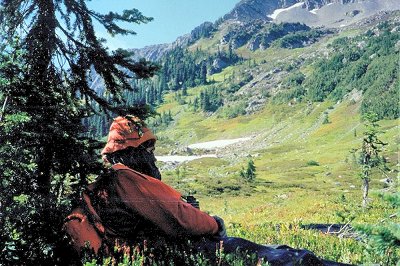 one I could find….essentially just a loose-fitting mesh bag. Larry and Howard both had some kind of internal binding in their masks, which kept the material close to their face and the eye holes would actually line up with their eyes. My cheap head bag did not have eye holes so I got out my jackknife and made some. The problem: I had no internal binding and the holes wouldn't stay lined up with my eyes. Half the time my nose stuck out one hole and my ear the other. I could hear and smell really well but couldn't see a thing. I finally stopped wearing it. Besides, what good does a face mask do when your white hands are flailing about like a member of the signal corps, trying to keep flies off the rest of your body? We needed a good killing frost but never got it.
one I could find….essentially just a loose-fitting mesh bag. Larry and Howard both had some kind of internal binding in their masks, which kept the material close to their face and the eye holes would actually line up with their eyes. My cheap head bag did not have eye holes so I got out my jackknife and made some. The problem: I had no internal binding and the holes wouldn't stay lined up with my eyes. Half the time my nose stuck out one hole and my ear the other. I could hear and smell really well but couldn't see a thing. I finally stopped wearing it. Besides, what good does a face mask do when your white hands are flailing about like a member of the signal corps, trying to keep flies off the rest of your body? We needed a good killing frost but never got it.
 one I could find….essentially just a loose-fitting mesh bag. Larry and Howard both had some kind of internal binding in their masks, which kept the material close to their face and the eye holes would actually line up with their eyes. My cheap head bag did not have eye holes so I got out my jackknife and made some. The problem: I had no internal binding and the holes wouldn't stay lined up with my eyes. Half the time my nose stuck out one hole and my ear the other. I could hear and smell really well but couldn't see a thing. I finally stopped wearing it. Besides, what good does a face mask do when your white hands are flailing about like a member of the signal corps, trying to keep flies off the rest of your body? We needed a good killing frost but never got it.
one I could find….essentially just a loose-fitting mesh bag. Larry and Howard both had some kind of internal binding in their masks, which kept the material close to their face and the eye holes would actually line up with their eyes. My cheap head bag did not have eye holes so I got out my jackknife and made some. The problem: I had no internal binding and the holes wouldn't stay lined up with my eyes. Half the time my nose stuck out one hole and my ear the other. I could hear and smell really well but couldn't see a thing. I finally stopped wearing it. Besides, what good does a face mask do when your white hands are flailing about like a member of the signal corps, trying to keep flies off the rest of your body? We needed a good killing frost but never got it.The Topography & Geology
Seemingly uphill, both from and to camp. We camped within forested cover but hunted in relatively open basins above the tree line. 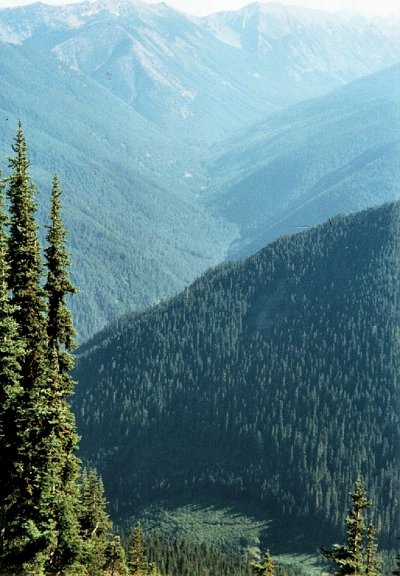 The ridge tops were broken, rugged rock with long, steep talus slopes descending from them. Occasional rock outcroppings, mixed with patches of timber and brush, provided great bedding areas for deer. Open meadows, covered with huckleberries, were good foraging areas for bear. The berries were just starting to show some color by the time we left so we probably missed the bears by about a week. Well, except for one. More on that later.
The ridge tops were broken, rugged rock with long, steep talus slopes descending from them. Occasional rock outcroppings, mixed with patches of timber and brush, provided great bedding areas for deer. Open meadows, covered with huckleberries, were good foraging areas for bear. The berries were just starting to show some color by the time we left so we probably missed the bears by about a week. Well, except for one. More on that later.
 The ridge tops were broken, rugged rock with long, steep talus slopes descending from them. Occasional rock outcroppings, mixed with patches of timber and brush, provided great bedding areas for deer. Open meadows, covered with huckleberries, were good foraging areas for bear. The berries were just starting to show some color by the time we left so we probably missed the bears by about a week. Well, except for one. More on that later.
The ridge tops were broken, rugged rock with long, steep talus slopes descending from them. Occasional rock outcroppings, mixed with patches of timber and brush, provided great bedding areas for deer. Open meadows, covered with huckleberries, were good foraging areas for bear. The berries were just starting to show some color by the time we left so we probably missed the bears by about a week. Well, except for one. More on that later.In places, there were large boulder fields (large fields with large boulders). I spent a little time poking around in these piles of rock because they were pretty interesting. First of all, there was a lot of mining activity and some of the rock appeared to be rotten quartz, which I've read can be a good source for gold. In my active imagination, I was looking for the nugget that would pay for the trip. Also, there was the biggest selection of conglomerate rock I've ever seen. Lastly, there was sedimentary rock that showed a very clear gradient of very coarse to very fine granular deposits-one on top of the other. This rock came from the very highest peaks in these open basins, which either meant the entire area was underwater at one time, or, these rugged peaks were forced upward from sea level by a cataclysmic event. Pretty intriguing. I could have spent several days just poking around with a rock hammer.
And just how many monster bucks made their escape while I was performing my geologist duties remains a mystery.
One day we hiked to the top of Anacortes Crossing at an elevation of about 7,000 feet. 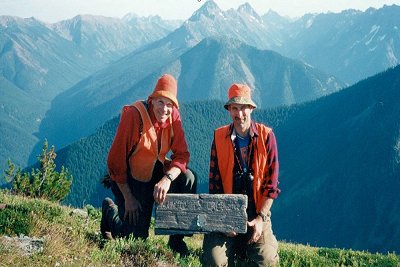 What a panorama! We could see south to Majestic Mountain and Azurite Peak; northeast to Shull Mountain; east back to Harts Pass, from where we entered the area; and west to Ross Lake. Actually I saw just a very small sliver of the lake on the first day while trying to drive some deer out of bedding area. After that, the smoke and/or haze was too thick to see the lake. Although there are several surrounding peaks that are higher, while at Anacortes Crossing it felt like we were on top of the world.
What a panorama! We could see south to Majestic Mountain and Azurite Peak; northeast to Shull Mountain; east back to Harts Pass, from where we entered the area; and west to Ross Lake. Actually I saw just a very small sliver of the lake on the first day while trying to drive some deer out of bedding area. After that, the smoke and/or haze was too thick to see the lake. Although there are several surrounding peaks that are higher, while at Anacortes Crossing it felt like we were on top of the world.
 What a panorama! We could see south to Majestic Mountain and Azurite Peak; northeast to Shull Mountain; east back to Harts Pass, from where we entered the area; and west to Ross Lake. Actually I saw just a very small sliver of the lake on the first day while trying to drive some deer out of bedding area. After that, the smoke and/or haze was too thick to see the lake. Although there are several surrounding peaks that are higher, while at Anacortes Crossing it felt like we were on top of the world.
What a panorama! We could see south to Majestic Mountain and Azurite Peak; northeast to Shull Mountain; east back to Harts Pass, from where we entered the area; and west to Ross Lake. Actually I saw just a very small sliver of the lake on the first day while trying to drive some deer out of bedding area. After that, the smoke and/or haze was too thick to see the lake. Although there are several surrounding peaks that are higher, while at Anacortes Crossing it felt like we were on top of the world.The Hunt
So, that's a lot of stuff to write about a hunting trip without actually mentioning the hunting. That's because I found other aspects of the trip so interesting and the hunting, by comparison, was a little uneventful. Well….almost.
There are basically 3 places to hunt, within 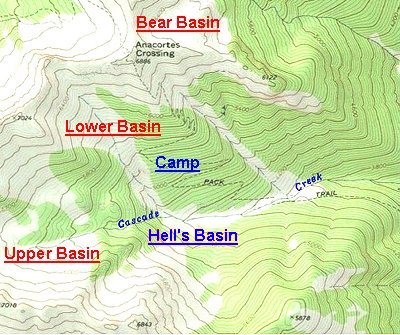 reasonable hiking distance:
reasonable hiking distance:
 reasonable hiking distance:
reasonable hiking distance: 1. The Lower Basin
2. The Upper Basin
3. Bear Basin
The Lower Basin starts at the south end of the second switchback after climbing out of camp. To reach the Upper Basin, contour through the Lower Basin and pick up an old trail which climbs into the Upper Basin. Both the Lower and Upper Basins are parts of Hells Basin. Bear Basin is reached by following the main trail up to Anacortes Crossing and then dropping down the face of the ridge to glassing points.
We did the former the first day, easing out of the timber right at daybreak and began glassing the open basin. Since we entered the basin at the bottom, we were glassing uphill and it wasn't too long before all the blood ran out of my arms while trying to hold up the binoculars. Within only a few minutes, we saw our first deer. They were almost at the top of the basin and feeding toward an area of rocks and timber. I spotted the first one and Larry the second. He said his had a good set of antlers but by the time he got his spotting scope set up, they had disappeared into the timber.
We got intermittent glimpses of them as they fed through the cover but eventually lost them. Assuming they bedded down, we planned our attack. I volunteered (stupidly) to climb into the top of the basin and try to spook the deer back down to Larry or Howard. The climb seemed about 5 degrees short of vertical and I was really sucking wind by the time I reached the top. Since I was so close to the ridge top, I dropped my day pack and climbed the extra 50 feet to peek over. There lay another huge basin, about 5 times the size of the one we were hunting. The air was clear and it was at that point when I got a clear glimpse of that sliver of Ross Lake, way off in the distance. I watched for a while but saw no animal activity in the other basin.
I eased my way back down the hill through the timber and rocks, moving slowly so if I did push the deer ahead of me they wouldn't be spooked and running hard. When I hooked back up with Larry and Howard, they had seen nothing. We dropped back into the bottom of the basin and picked up the trail leading into Hell's Basin. We found an area in the shade and spent the rest of the day just sitting and watching. We saw no action except, of course, from the incessant insects.
through the timber and rocks, moving slowly so if I did push the deer ahead of me they wouldn't be spooked and running hard. When I hooked back up with Larry and Howard, they had seen nothing. We dropped back into the bottom of the basin and picked up the trail leading into Hell's Basin. We found an area in the shade and spent the rest of the day just sitting and watching. We saw no action except, of course, from the incessant insects.
 through the timber and rocks, moving slowly so if I did push the deer ahead of me they wouldn't be spooked and running hard. When I hooked back up with Larry and Howard, they had seen nothing. We dropped back into the bottom of the basin and picked up the trail leading into Hell's Basin. We found an area in the shade and spent the rest of the day just sitting and watching. We saw no action except, of course, from the incessant insects.
through the timber and rocks, moving slowly so if I did push the deer ahead of me they wouldn't be spooked and running hard. When I hooked back up with Larry and Howard, they had seen nothing. We dropped back into the bottom of the basin and picked up the trail leading into Hell's Basin. We found an area in the shade and spent the rest of the day just sitting and watching. We saw no action except, of course, from the incessant insects.The next day was a little more exciting. As the rookie, I was really on a roll. The first morning, we were 50 yards down the trail from camp when I realized I'd forgotten my rifle shells. The second day, we had gone almost a half mile when I realized I had left my orange vest and binoculars behind. Each day I had to tell the guys to go on without me and I'd catch up. I'd drop my gun and pack and huff back to camp. Once I had all my parts, I'd huff back up the trail and join the guys where they had stopped to look for deer. They had spotted a one doe but nothing else. After assuring there was no further activity, we continued on to Bear Basin. They call it that because they always see bears there.
The trail was almost imperceptible, very steep and very treacherous because of all the shale slides. We cautiously picked our way along and eventually crawled up on the sharp spine of a ridge. Peering carefully over the other side, we could see yet another basin with lots of promise. This was what the guys called Bear Basin. We strung ourselves out along the ridge a few yards apart and settled in to watch. At about 11:00 we decided to move up the ridge for a better perspective. Howard had to "see a man about a horse" and disappeared into the brush. Larry and I had moved about 50 years up the ridge with Larry in the lead, when I looked across the basin and saw a large black bear coming down across a completely bare shale slide. Larry didn't see it and I hissed at him twice before I got his attention. After seeing the bear, he gave me a grin and a nod. He told me to head back toward our original sitting spot and set up while he watched the bear. As I was scuttling back down the ridge I was hoping Howard would rejoin us so we could fill him in on this new development.
Peering carefully over the other side, we could see yet another basin with lots of promise. This was what the guys called Bear Basin. We strung ourselves out along the ridge a few yards apart and settled in to watch. At about 11:00 we decided to move up the ridge for a better perspective. Howard had to "see a man about a horse" and disappeared into the brush. Larry and I had moved about 50 years up the ridge with Larry in the lead, when I looked across the basin and saw a large black bear coming down across a completely bare shale slide. Larry didn't see it and I hissed at him twice before I got his attention. After seeing the bear, he gave me a grin and a nod. He told me to head back toward our original sitting spot and set up while he watched the bear. As I was scuttling back down the ridge I was hoping Howard would rejoin us so we could fill him in on this new development.
 Peering carefully over the other side, we could see yet another basin with lots of promise. This was what the guys called Bear Basin. We strung ourselves out along the ridge a few yards apart and settled in to watch. At about 11:00 we decided to move up the ridge for a better perspective. Howard had to "see a man about a horse" and disappeared into the brush. Larry and I had moved about 50 years up the ridge with Larry in the lead, when I looked across the basin and saw a large black bear coming down across a completely bare shale slide. Larry didn't see it and I hissed at him twice before I got his attention. After seeing the bear, he gave me a grin and a nod. He told me to head back toward our original sitting spot and set up while he watched the bear. As I was scuttling back down the ridge I was hoping Howard would rejoin us so we could fill him in on this new development.
Peering carefully over the other side, we could see yet another basin with lots of promise. This was what the guys called Bear Basin. We strung ourselves out along the ridge a few yards apart and settled in to watch. At about 11:00 we decided to move up the ridge for a better perspective. Howard had to "see a man about a horse" and disappeared into the brush. Larry and I had moved about 50 years up the ridge with Larry in the lead, when I looked across the basin and saw a large black bear coming down across a completely bare shale slide. Larry didn't see it and I hissed at him twice before I got his attention. After seeing the bear, he gave me a grin and a nod. He told me to head back toward our original sitting spot and set up while he watched the bear. As I was scuttling back down the ridge I was hoping Howard would rejoin us so we could fill him in on this new development.I crawled to the edge of the ridge and laid my day pack down for a gun rest. Then I waited. The bear had disappeared into a fold in the terrain and there was no way to know if we'd see him again.  Larry joined me and we continued to wait. After just a few minutes, Larry saw the bear coming over a knob about 275 yards away. Instead of continuing toward us, he began quartering away. Larry got up and told me to follow him down the ridge to a point where we could partially close the gap. He was pretty brazen in his movement down the ridge while I was all hunched over, trying to use the ridge as cover. Larry had hunted bears enough to know that their eyesight is so poor, they generally don't even see you from that distance.
Larry joined me and we continued to wait. After just a few minutes, Larry saw the bear coming over a knob about 275 yards away. Instead of continuing toward us, he began quartering away. Larry got up and told me to follow him down the ridge to a point where we could partially close the gap. He was pretty brazen in his movement down the ridge while I was all hunched over, trying to use the ridge as cover. Larry had hunted bears enough to know that their eyesight is so poor, they generally don't even see you from that distance.
 Larry joined me and we continued to wait. After just a few minutes, Larry saw the bear coming over a knob about 275 yards away. Instead of continuing toward us, he began quartering away. Larry got up and told me to follow him down the ridge to a point where we could partially close the gap. He was pretty brazen in his movement down the ridge while I was all hunched over, trying to use the ridge as cover. Larry had hunted bears enough to know that their eyesight is so poor, they generally don't even see you from that distance.
Larry joined me and we continued to wait. After just a few minutes, Larry saw the bear coming over a knob about 275 yards away. Instead of continuing toward us, he began quartering away. Larry got up and told me to follow him down the ridge to a point where we could partially close the gap. He was pretty brazen in his movement down the ridge while I was all hunched over, trying to use the ridge as cover. Larry had hunted bears enough to know that their eyesight is so poor, they generally don't even see you from that distance.I need to back up here for a minute. I was on this hunt as a first time guest and had no intention of being the first guy to shoot at anything….especially a buck. I would have been perfectly content to go back up to the LPO in November and hunt whitetails. If I got a chance at a nice big mule deer buck, I certainly wouldn't turn it down but my intentions were to do so only after Larry and Howard had filled their tags, or if I saw one while by myself. I was pretty certain that would not happen, based on their historic accounts of hunting success in this area.
A bear was a different story. Both Howard and Larry had killed bears before and I'd never gotten one. Although there had been some casual talk about me shooting a bear, I still wasn't totally comfortable with taking that first shot. When Larry and I settled in with the bear in sight, I asked him if he wanted to shoot it. He said, "No, you spotted it". I briefly argued with him, although half-heartedly and he finally said, "You better shoot it!" That was enough for me.
Earlier in the day, Howard had shown me how to use his range finder. I practiced with it a bit before putting it back in his pack. Now as Larry left to head down to a better vantage point, I quickly gathered up all my stuff, and as an afterthought, rifled through Howard's unattended pack and grabbed the range finder. When I caught up with Larry, I dropped my stuff and took a quick reading on the bear….312 yards. I looked at Larry. He said go for it. Again, I laid my day pack down on the very edge of the ridge so my muzzle was hanging out over the edge. I didn't want a small piece of heather or grass deflecting the shot. I laid on my belly and picked up the bear in my scope. He was continuing a purposeful walk, quartering away. At nine power, my scope had a small field of view and the bear's constant movement kept him entering and leaving that field of view quickly. I had to constantly shift my body sideways and hold the scope out ahead of him to wait for him to walk into it. Due to the long distance, I didn't want to take the shot on a moving bear but I knew if he hesitated it might only be for an instant…..not enough time to shift body position AND settle the crosshairs. My goal was to have him walk into my field of view and stop at the precise moment I was settled in for the shot.
Finally! The bear turned broadside and stopped. I had my rifle sighted in 3 inches high at 100 yards. The point of impact would climb another inch at 200 yards which would put it right on the money between 275 and 300 yards. I was still contemplating that 312 yard figure I had ranged the bear at, held dead still behind his right shoulder and touched off. The .270's recoil pulled me clear of the bear but I could see him running and got the scope back on him quickly. And then he was gone, disappearing into the heavy timber in just a couple seconds. I couldn't believe how fast he moved, almost like he was sliding on his belly. Larry said, "You hit him hard! You got him!" That's when the nervousness caught up to me.
Howard had heard the shots and tracked us down when we relived the last few moments. I pointed out where the bear was and Howard asked where I was holding when I shot. When I told him he said I may have shot under him. I didn't believe him at first, thinking the bear was down, but in retrospect, I should have known. Howard has been around the hunting block a time or two…much more so than me. He recognized the distance issue right away.
And then, staring across to where the bear disappeared, it hit me. This bear was down in a huge hole, on the opposite side of the ridge from our camp. If I had truly gotten that bear, we had a bugger of a pack job ahead of us. We slowly made our way down the steep slope and into the bottom where I had noted some reference points close to the bear's location. We spread out and looked everywhere but found no sign of blood. We started re-enacting the incident and began to wonder if I really hit the bear at all. Larry said the bear first snapped his head back toward his shoulder and an instant later began his downhill run. That behavior would indicate a hit, but if I shot below him, as Howard said, I could have easily splattered him with rocks. That, plus the delayed sound of the gunshot reaching him, could have easily spooked him into his frantic departure. After a thorough search, we slowly trudged back up out of the bottom.
Two days later, when we hunted this basin again, I used Howard's range finder to get the distance to the exact point of impact….380 yards! I had not taken into consideration the fact that as the bear quartered away from us, he increased the distance with each successive step. By the time he stopped, he was well beyond the range I was aiming for. I was relieved at the confirmation that I could not have hit him with that shot. I'd do a lot of things differently if I had it to do over again but hindsight is always 20:20.
After crawling out of that basin with thighs screaming, we decided to further abuse ourselves by continuing upwards to Anacortes Crossing.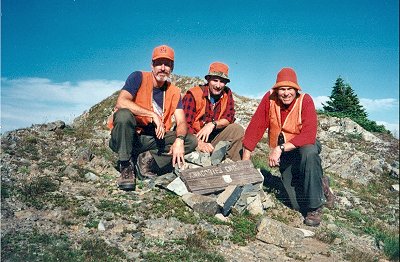 After reaching the summit, we paused for some pictures and for Howard to point out some of the various peaks and other features in this 360 degree panorama. Then we began our slow descent along a very steep set of switchbacks and eventually back to camp. About a mile from camp a young blue grouse gave away his location in some low bush huckleberries and Larry secured him for dinner with a clean head shot.
After reaching the summit, we paused for some pictures and for Howard to point out some of the various peaks and other features in this 360 degree panorama. Then we began our slow descent along a very steep set of switchbacks and eventually back to camp. About a mile from camp a young blue grouse gave away his location in some low bush huckleberries and Larry secured him for dinner with a clean head shot.
 After reaching the summit, we paused for some pictures and for Howard to point out some of the various peaks and other features in this 360 degree panorama. Then we began our slow descent along a very steep set of switchbacks and eventually back to camp. About a mile from camp a young blue grouse gave away his location in some low bush huckleberries and Larry secured him for dinner with a clean head shot.
After reaching the summit, we paused for some pictures and for Howard to point out some of the various peaks and other features in this 360 degree panorama. Then we began our slow descent along a very steep set of switchbacks and eventually back to camp. About a mile from camp a young blue grouse gave away his location in some low bush huckleberries and Larry secured him for dinner with a clean head shot.The next day we again hunted the Lower Basin and Hell's Basin (thankfully) and gave ourselves a well-deserved rest. While sitting in Hell's Basin about 8:30 that morning, we had 12 blue grouse fly out of two scraggly pine trees way up the basin and soar down the ill right past us. They came out in singles and in pairs and landed in the trees behind us. We spent the entire day in that basin and saw no big game but in the late afternoon we made 2 passes through the huckleberry fields and timber and got 2 more grouse. 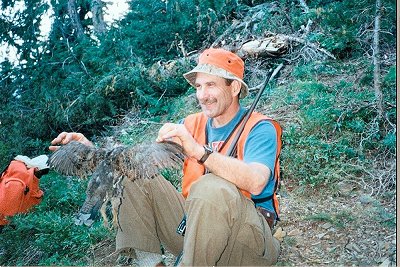 Larry got them both after I missed the first one. With a gun sighted in for such long distances, I had no idea where to hold on a grouse 10 yards away. At that distance, I would have expected the muzzle blast to knock him over. These birds were older and tougher than the one the night before but they were still mighty good.
Larry got them both after I missed the first one. With a gun sighted in for such long distances, I had no idea where to hold on a grouse 10 yards away. At that distance, I would have expected the muzzle blast to knock him over. These birds were older and tougher than the one the night before but they were still mighty good.
 Larry got them both after I missed the first one. With a gun sighted in for such long distances, I had no idea where to hold on a grouse 10 yards away. At that distance, I would have expected the muzzle blast to knock him over. These birds were older and tougher than the one the night before but they were still mighty good.
Larry got them both after I missed the first one. With a gun sighted in for such long distances, I had no idea where to hold on a grouse 10 yards away. At that distance, I would have expected the muzzle blast to knock him over. These birds were older and tougher than the one the night before but they were still mighty good.The last day of hunting took us back to Bear Basin where we spent the entire day. Again, we saw no big game but we had taken our pack frames with us so we wouldn't have to go back to camp for them if we were successful. So, no meat in the freezer for all our effort but there's always more to a hunt than filling a tag and that was certainly the case for me on this hunt.
The Trip Out
We had everything packed up early and headed down the trail with noticeably lighter loads now that we had eaten all our food. The trip out was nothing out of the ordinary except for one thing. About halfway to Chancellor Campground, just as we approached the creek crossing, we found an obvious tent imprint in the weeds next to the trail. We thought we had seen a footprint when we were hunting be we had forgotten about it. We continued down the trail, reaching the slide and belayed each other across. Around the next switchback was a dome tent pitched directly in the trail, with the door facing away from us. Larry was in the lead and called out in case someone was inside.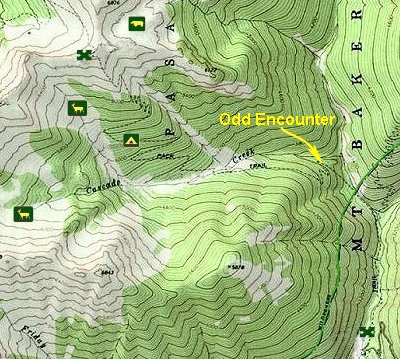 We had to actually climb up on the hillside to get around the tent. Larry dropped back down on to the trial and greeted someone in the tent. As I came around the tent I peeked in and saw a single guy, lying on some beat up blankets, just staring out at us. We asked him how he was doing and he was almost unresponsive. Howard brought up the rear and also greeted the guy and got no response. I could feel the hair on the back of my neck start to prickle and just wanted to keep on moving down the trail.
We had to actually climb up on the hillside to get around the tent. Larry dropped back down on to the trial and greeted someone in the tent. As I came around the tent I peeked in and saw a single guy, lying on some beat up blankets, just staring out at us. We asked him how he was doing and he was almost unresponsive. Howard brought up the rear and also greeted the guy and got no response. I could feel the hair on the back of my neck start to prickle and just wanted to keep on moving down the trail.
 We had to actually climb up on the hillside to get around the tent. Larry dropped back down on to the trial and greeted someone in the tent. As I came around the tent I peeked in and saw a single guy, lying on some beat up blankets, just staring out at us. We asked him how he was doing and he was almost unresponsive. Howard brought up the rear and also greeted the guy and got no response. I could feel the hair on the back of my neck start to prickle and just wanted to keep on moving down the trail.
We had to actually climb up on the hillside to get around the tent. Larry dropped back down on to the trial and greeted someone in the tent. As I came around the tent I peeked in and saw a single guy, lying on some beat up blankets, just staring out at us. We asked him how he was doing and he was almost unresponsive. Howard brought up the rear and also greeted the guy and got no response. I could feel the hair on the back of my neck start to prickle and just wanted to keep on moving down the trail. But not Howard. He also recognized something was wrong with this picture and kept trying to get a dialogue going with the guy. I got the impression he didn't want to be bothered. Another clue that something was amiss was the half-eaten corncob next to the tent door…not exactly your most efficient trail food. Eventually Howard gave up and we left. After going about 100 yards, Howard stopped and said he was going back. He was afraid the guy was lost and we would be "Reading about him in the papers". I tried to talk him out of it because the guy was just too weird but Howard had already dropped his pack and was headed back up the trail. Larry and I scrambled out of our packs and hustled after him.
Between the 3 of us, we could not figure out what was wrong with this guy. We talked to him for about 10 minutes and clearly, he was just not in his right mind. He had no map, no water, didn't know where north was, no sleeping bag, no idea about the country he was in, and was hiking in tennis shoes with one pair of holey socks. He claimed he had lots of food but I hoped it wasn't all corn on the cob. We gave him some water and got him pointed back down toward the highway. Then we went on down the trail ahead of him while he packed his gear. We eventually stopped for lunch and were just about finished when he came back down the trail. He had his blankets rolled up under one arm and all the rest of his stuff in a duffle bag that was slung over his shoulder. He barely acknowledged us as he went by. I would have been content to leave him in his tent. Thankfully, Howard wasn't willing to do that. I'm sure now that we would indeed have read about this guy in the paper after they found his body. I just don't think he would have made it out of the mountains alive. This will probably always remain a mystery.
The rest of the hike went quickly. We got to Chancellor, dug our cart out of the brush, loaded up and headed out. The first half mile is a steep climb out of the creek bottom. I started out on the back of the cart and after only going 200 yards I felt like my lungs were going to burst. I realized later that I was just pushing too hard and moving too fast. Once we slowed the pace, I got my wind back. The trip to the truck went by in record time, or so they told me, probably because of my initial wind sprint out of the bottom.
This was a totally different hunt for me. There were times when I figured I wouldn't come back, even if they asked me. I'd been on backpack hunts before but this was just too grueling. But as the days went by, I began to feel a sense of accomplishment. To have the ability to pack a camp into that kind of country, kill a big game animal, and pack it all out…. I'd probably remember that for a long time. Yeah, I'd go again. Guess I'll have to wait a year to see if I get another invitation
Epilogue
by
Howard Gardner
When I retired in 1991 I decided to again start backpack hunting the high country for buck deer in our states early deer season. By studying Geological Survey maps of the Harts Pass area, I found a region in the Pasayten Wilderness Area that looked interesting. I got together with Larry Martin to see he if would be interested in going on a six or seven day backpack hunt in country that I had never been in before. He agreed and we planned a trip. This was the first of nine consecutive trips to the area dominated by Hells Basin and Anacortes Crossing. We always camped at an abandoned mine as I found out later was the Anacortes Mine. The first two trips we harvested one 3x2 and one 5x3 point buck. But, then an expanding cougar population essentially eliminated the deer from this area. Of course, we didn't realize this for a couple of years so we continued going and harvested three nice black bears, one of which was the largest I’ve ever shot. In a good huckleberry year we always saw bear. This brings us to the 1999 hunt which Rocky so expertly described.
As it turned out this was our last hunt in the Pasayten area. The main reason was the scarcity of bucks and for me, a realization that I’m no longer sure footed and therefore a hazard to myself and my partners. Collectively it was an outstanding experience and I miss it.
